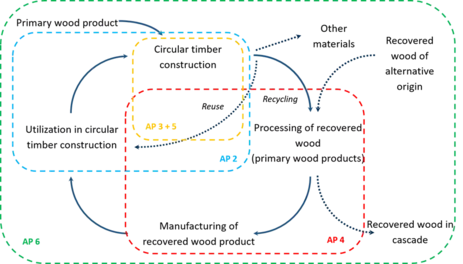Timber Use and Maintain – TU&M
Development and evaluation of circular timber panel constructions under the premise of a technical, economic and ecological feasibility.
Description of the joint project
An interdisciplinary consortium of research and industry partners is carrying out the research project. Starting with the investigations at the building level, the flexibility of use and adaptability of circular timber panel construction designs are evaluated. On the building construction level, i.e. component level, circular timber panel structures are developed and optimized, under consideration of the respective application (i.e. wall, roof, ceiling element). To enable the dismantling of the building, the connections between the construction panels are in focus. At the material level, the qualitative and quantitative assessment of recovered solid wood properties and their cascading potential is in focus. The characterization of the cascading potential of the recovered wood at the material level helps to ensure the most resource efficient pathway after deconstruction and disassembly. A holistic view across all levels allows the integration of digital technologies for the development of a digital material passport, with the aim of documenting and tracking components, connections and deconstruction options. In addition to the technical and material assessment, based on the life cycle analyses, the ecological und economic impacts of circular timber panel elements are evaluated. The analysis of innovative economic concepts such as leasing or sharing models from the Circular Economy provides a glimpse into the future of modern timber construction.

Research focus HFM
The main task for the Chair of Wood Science, represented by the research area Material Flow Management, is to determine the properties and usability of used wood products in timber construction. The aim is to characterise used wood properties in order to be able to qualitatively and quantitatively represent losses of the quality of the wood during the demolition processes and recovery processes. Potential building products for timber panel construction are identified from the current material flow of used wood. In parallel, the environmental impacts of the circular timber panel elements in comparison to the status-quo are analyzed using life cycle based assessment methods. Based on test series, recommendations for the minimum quality of used wood after deconstruction are derived.
| Duration | 01/2023 – 12/2025 |
| People | Chair of Wood Science: Böhm, F.; Risse, M.; Weber-Blaschke, G.; Richter, K. |
| Processing of work packages AP 1 (project management and dissemination) + AP 4 | |
| Research partners | Chair of Architecture and Timber Constructions (TU Munich), Processing of work package 2 |
| Chair of Timber Structures and Building Constructions (TU Munich), Processing of work package 3 | |
| Chair of Architectural Informatics (TU Munich), Processing of work package 5 | |
| Chair for Circular Economy (TU Munich), Processing of work package 6 | |
| Industrial partners | Brüninghoff Holz GmbH & Co. KG |
| Haas GmbH & Co. Beteiligungs KG | |
| Project website | - |
| Publications: | - |
| Funding: |

